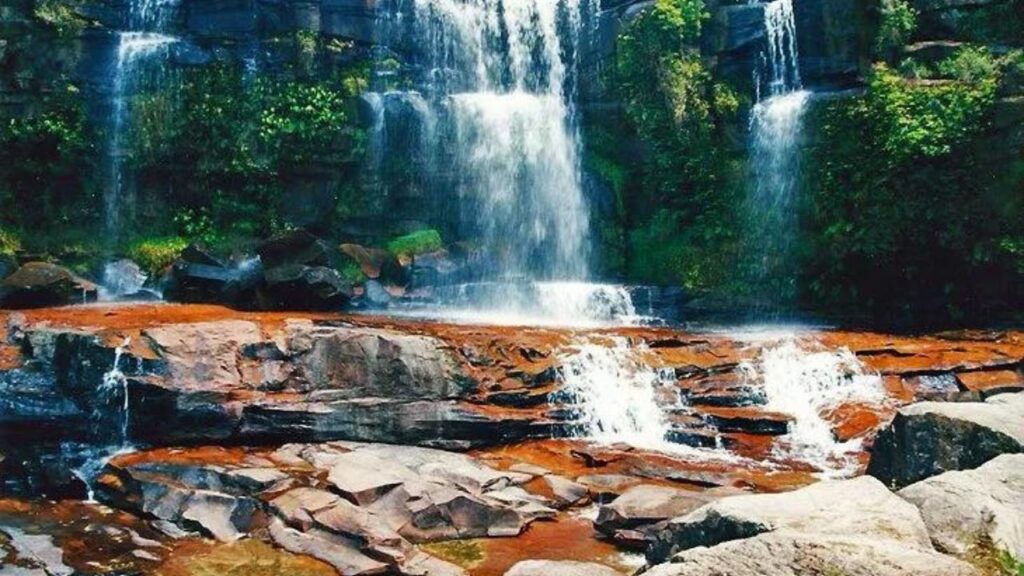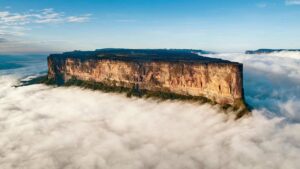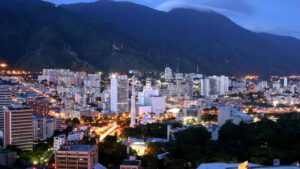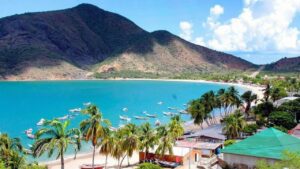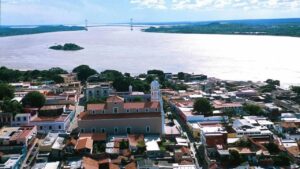Coro and Ciudad Bolivar, two colonial cities nestled in Venezuela, encapsulate centuries of history, culture, and architectural splendor. Founded in the early days of Spanish colonization, these cities served as vital centers of trade, governance, and cultural exchange during the colonial era. Coro, with its UNESCO World Heritage Site designation, boasts a well-preserved historic center adorned with colonial-era buildings and landmarks.
Meanwhile, Ciudad Bolivar, once known as Angostura, played a pivotal role in Venezuela’s struggle for independence and continues to enchant visitors with its picturesque streets and significant monuments. Together, these cities offer a captivating journey into Venezuela’s colonial past.
1. Canaima National Park
Canaima National Park, a UNESCO World Heritage Site located in southeastern Venezuela, best cities to visit in venezuela, is a vast wilderness area renowned for its stunning landscapes and rich biodiversity. Spanning over 30,000 square kilometers, the park encompasses dense rainforests, towering tepuis (tabletop mountains), and cascading waterfalls, including the iconic Angel Falls, the tallest waterfall in the world.
Activities Available
Visitors to Canaima National Park can partake in a variety of outdoor adventures amidst its pristine natural beauty. Popular activities include:
- Trekking: Explore scenic trails that wind through the park’s diverse ecosystems, offering opportunities to encounter rare wildlife and breathtaking vistas.
- Canoeing and Boating: Navigate the park’s network of rivers and lagoons by canoe or motorboat, taking in the majestic scenery and visiting remote indigenous villages along the way.
- Waterfall Excursions: Embark on guided tours to marvel at the park’s numerous waterfalls, including the awe-inspiring Angel Falls, where adventurous travelers can swim in natural pools at the base of the cascades.
Accommodation Options
While Canaima National Park is primarily a wilderness area, there are several accommodation options available for visitors seeking to immerse themselves in the natural splendor of the park:
- Camping: Adventurous travelers can pitch tents at designated campsites within the park, providing an immersive outdoor experience beneath the starlit skies of Canaima.
- Luxury Lodges: For those seeking more upscale accommodations, a few luxury lodges and resorts are located on the outskirts of the park, offering comfortable rooms, gourmet dining, and guided tours in air-conditioned comfort.
2. Los Roques Archipelago
The Los Roques Archipelago, situated off the northern coast of Venezuela in the Caribbean Sea, is a pristine marine park comprising over 300 islands, great places to visit in venezuela, cays, and islets. Known for its crystal-clear turquoise waters, powdery white sand beaches, and vibrant coral reefs, Los Roques is a paradise for beach lovers, snorkelers, and nature enthusiasts alike.
The Archipelago: Los Roques Archipelago is a haven for travelers seeking tranquility and natural beauty amidst a secluded island paradise. The archipelago’s remote location and protected status have helped preserve its pristine ecosystems, making it a UNESCO World Biosphere Reserve and one of Venezuela’s most treasured natural gems.
Popular Activities
Visitors to Los Roques can indulge in a variety of activities that showcase the archipelago’s natural wonders:
- Snorkeling and Diving: Explore the vibrant coral reefs teeming with colorful marine life, including tropical fish, sea turtles, and rays, in the archipelago’s warm, clear waters.
- Beachcombing: Relax on pristine beaches lined with soft, white sand and swaying palm trees, perfect for sunbathing, picnicking, or simply enjoying the tranquil surroundings.
- Kiteboarding and Windsurfing: Take advantage of the archipelago’s steady trade winds and shallow lagoons, ideal for adrenaline-pumping water sports like kiteboarding and windsurfing.
Recommended Islands to Visit
While all of the islands in Los Roques offer their unique charm and beauty, some stand out as must-visit destinations:
- Cayo de Agua: Known for its stunning sandbars, shallow lagoons, best places to visit in caracas venezuela, and crystal-clear waters, Cayo de Agua is a popular spot for swimming, snorkeling, and beach picnics.
- Francisco: This picturesque island boasts secluded beaches, lush vegetation, and excellent snorkeling opportunities along its coral reefs.
- Crasqui: With its tranquil atmosphere and pristine beaches, Crasqui is the perfect island for relaxation and solitude, ideal for a peaceful day of sunbathing and swimming.
3. Mount Roraima
Mount Roraima, often referred to as the “Floating Island,” is a massive flat-topped mountain located at the tripoint border of Venezuela, Brazil, and Guyana in South America. This ancient geological formation, believed to be over two billion years old, rises abruptly from the surrounding rainforest, its sheer cliffs towering over 1,000 meters above the jungle below.
Description of the Mountain: Mount Roraima’s distinctive tabletop summit spans an area of approximately 31 square kilometers, making it one of the largest tepuis (tabletop mountains) in the world. Its sheer vertical cliffs and flat, barren plateau give it an otherworldly appearance, shrouded in mist and clouds that often cloak its summit.
Trekking Opportunities: Trekking to the summit of Mount Roraima is a bucket-list adventure for outdoor enthusiasts and nature lovers. The most popular trekking route begins in the Gran Sabana region of Venezuela, where hikers embark on a multi-day journey through dense rainforests, across rocky terrain, and up steep slopes to reach the mountain’s summit. Along the way, trekkers encounter breathtaking landscapes, diverse ecosystems, and unique flora and fauna found nowhere else on Earth.
Unique Features: Additionally, Mount Roraima holds cultural significance for indigenous communities, who consider it a sacred place inhabited by powerful spirits and ancient legends.
4. Morrocoy National Park
Morrocoy National Park, located along Venezuela’s central coast, is a coastal paradise renowned for its pristine beaches, crystal-clear waters, and rich biodiversity. This protected marine park encompasses a diverse range of ecosystems, including mangrove forests, top cities to visit in venezuela, coral reefs, and sandy cays, making it a popular destination for beachgoers, water sports enthusiasts, and nature lovers alike.
What it Offers
Morrocoy National Park offers visitors a wide array of attractions and activities to enjoy:
- Stunning Beaches: The park is home to numerous idyllic beaches with powdery white sands and calm turquoise waters, perfect for sunbathing, swimming, and beachcombing.
- Water Activities: Visitors can partake in a variety of water sports and recreational activities, including snorkeling, scuba diving, kayaking, and paddleboarding, to explore the park’s vibrant underwater world and pristine coral reefs.
- Boat Tours: Guided boat tours are available for visitors to explore the park’s picturesque islands, secluded cays, and hidden lagoons, offering opportunities for sightseeing, wildlife spotting, and snorkeling at remote reef sites.
- Island Hopping: With over 50 islands and cays scattered throughout the park, island hopping is a popular activity, allowing visitors to discover secluded beaches, tranquil bays, and scenic viewpoints.
Beaches and Water Activities
Morrocoy National Park boasts some of the most beautiful beaches in Venezuela, including Playa Mero, Playuela, and Cayo Sombrero, each offering pristine sands, calm waters, and excellent snorkeling opportunities. Visitors can swim, sunbathe, and relax on the beaches or explore the underwater world teeming with colorful fish, coral formations, and marine life.
Wildlife Encounters: While Morrocoy National Park is primarily known for its marine environment, it is also home to a diverse array of terrestrial and avian species. Visitors may encounter wildlife such as iguanas, hermit crabs, and seabirds while exploring the park’s mangrove forests, coastal scrublands, and rocky outcrops.
AOverall, Morrocoy National Park offers a perfect blend of natural beauty, outdoor adventure, and wildlife encounters, making it an ideal destination for travelers seeking a tropical escape along Venezuela’s stunning coastline.
5. Merida
Merida, nestled in the Andes Mountains of western Venezuela, is a vibrant city known for its colonial charm, cultural heritage, and outdoor adventures. Situated at an elevation of over 1,500 meters, Merida boasts a pleasant climate, stunning mountain scenery, and a wealth of attractions and activities for visitors to enjoy.
City Overview: Founded in 1558 by Spanish conquistadors, good places to go in venezuela, Merida is one of Venezuela’s oldest cities, with a rich history and architectural heritage evident in its well-preserved colonial buildings, cobblestone streets, and charming plazas. The city serves as a hub for tourism, education, and commerce in the region, attracting visitors from around the world with its unique blend of tradition and modernity.
Attractions and Activities
Merida offers a wide range of attractions and activities to suit every traveler’s interests:
- Cable Car to Pico Bolivar: Ride the world’s longest and highest cable car, known locally as the “Teleférico,” to the summit of Pico Bolivar, Venezuela’s highest peak. Enjoy panoramic views of the Andes Mountains and surrounding countryside from the cable car cabins and observation decks.
- Historic Downtown: Explore Merida’s historic downtown area, home to colonial-era landmarks such as Plaza Bolivar, the Cathedral of Merida, and the Church of La Tendida. Wander through narrow streets lined with colorful buildings, artisan shops, and sidewalk cafes, soaking in the city’s unique atmosphere.
- Archaeological Museum: Visit the Archaeological Museum of Merida to learn about the region’s pre-Columbian history and indigenous cultures through exhibits featuring pottery, artifacts, and artwork dating back thousands of years.
- Andean Music and Dance: Experience the vibrant cultural scene of Merida by attending traditional music and dance performances featuring Andean instruments such as the cuatro, maracas, and Tambora, showcasing the region’s rich musical heritage.
Nearby Natural Wonders
- Merida serves as a gateway to some of Venezuela’s most spectacular natural wonders:
- Sierra Nevada National Park: Explore the rugged landscapes and diverse ecosystems of Sierra Nevada National Park, home to cloud forests, páramo grasslands, and high-altitude lakes. Hike scenic trails to waterfalls, glacial valleys, and mountain peaks, encountering unique flora and fauna along the way.
- Mucubaji Lagoon: Visit Mucubaji Lagoon, a picturesque alpine lake located within Sierra Nevada National Park, renowned for its crystal-clear waters, scenic surroundings, and opportunities for hiking, picnicking, and birdwatching.
- Los Aleros: Discover the charming Andean village of Los Aleros, a living museum showcasing traditional rural life in Venezuela. Explore replica colonial buildings, artisan workshops, and cultural exhibits, and enjoy horseback riding, folk music, and local cuisine.
Merida’s strategic location amidst the Andes Mountains offers endless opportunities for adventure, exploration, and cultural immersion, making it a must-visit destination for travelers seeking authentic experiences in the heart of Venezuela.
6. Cerro Autana
Cerro Autana, a majestic sandstone mesa located in the Venezuelan Amazon, is an iconic natural landmark revered for its breathtaking beauty, ecological significance, and cultural importance to indigenous communities. Rising abruptly from the surrounding rainforest, this ancient geological formation captivates travelers with its sheer cliffs, lush vegetation, and mystical aura.
Access and Hiking Options: Accessing Cerro Autana typically involves a journey by boat along the Ventura River, followed by a trek through the dense rainforest to reach the base of the mountain. From there, adventurous travelers can embark on guided hiking expeditions to explore the mountain’s rugged terrain, ascending steep trails and scrambling over rocky outcrops to reach its summit. Along the way, best places to go in caracas venezuelal, hikers may encounter exotic wildlife, tropical birds, and endemic flora, immersing themselves in the pristine wilderness of the Amazon.
Cultural Significance: Cerro Autana holds deep cultural significance for indigenous communities, particularly the Piaroa and Ye’kuana peoples who inhabit the surrounding rainforest. For centuries, indigenous shamans have revered Cerro Autana as a source of spiritual wisdom, healing energy, and cultural identity, passing down traditional knowledge and oral histories from generation to generation.
7. Caracas
Caracas, the bustling capital city of Venezuela, is a vibrant metropolis nestled in a valley surrounded by the majestic Avila Mountain. Known for its rich cultural heritage, lively atmosphere, and stunning landscapes, Caracas offers visitors a myriad of attractions, cultural experiences, and culinary delights to explore.
Capital City Highlights
- El Ávila National Park: Ascend the slopes of Avila Mountain via the iconic Teleférico cable car for panoramic views of the city and surrounding countryside. Enjoy hiking, picnicking, and birdwatching amidst the park’s lush forests and scenic trails.
- Plaza Bolívar: Visit the historic Plaza Bolívar, the heart of Caracas, adorned with statues, fountains, and colonial-era buildings. Explore landmarks such as the Cathedral of Caracas, the National Capitol, and the Bolívar Museum, dedicated to Venezuela’s revered independence hero.
- National Pantheon: Discover the National Pantheon, a neoclassical mausoleum housing the remains of Venezuela’s most prominent historical figures, including Simón Bolívar, the liberator of Latin America.
Cultural Experiences
-
- Theater and Arts: Immerse yourself in Caracas’ vibrant cultural scene by attending performances at renowned venues like the Teresa Carreño Cultural Complex and the Municipal Theater.
- Museums and Galleries: Explore Caracas’ diverse art and history museums, top 3 places to visit in venezuela, showcasing everything from pre-Columbian artifacts to contemporary Venezuelan art.
- Street Markets: Wander through bustling street markets like Mercado de los Pueblos, Mercado de Catia, and Mercado de Chacao to sample local delicacies, shop for handicrafts, and immerse yourself in the city’s vibrant street life.
Safety Tips
- Stay Alert: Be vigilant and aware of your surroundings, especially in crowded areas, markets, and public transportation.
- Avoid Flashy Displays: Keep valuables such as jewelry, cameras, and electronics out of sight to avoid attracting unwanted attention.
- Use Licensed Taxis: Opt for licensed taxis or reputable ride-sharing services like Uber for transportation, especially at night.
- Travel in Groups: Whenever possible, travel with companions and avoid exploring unfamiliar areas alone, particularly after dark.
- Respect Local Customs: Familiarize yourself with local customs and cultural norms to avoid inadvertently causing offense or misunderstanding.
While Caracas offers a wealth of cultural experiences and attractions, it’s essential to exercise caution and take necessary precautions to ensure a safe and enjoyable visit to this dynamic capital city of Venezuela.
8. The Orinoco Delta
The Orinoco Delta, located in northeastern Venezuela, is one of the largest river deltas in the world, spanning over 41,000 square kilometers. This vast and biodiverse region is characterized by a network of intricate waterways, lush tropical rainforests, and expansive wetlands, making it a unique and ecologically significant destination for travelers seeking adventure and exploration.
Overview of the Delta: The Orinoco Delta is formed by the convergence of the Orinoco River and its tributaries as they flow into the Atlantic Ocean. The delta’s complex system of rivers, channels, and mangrove forests creates a diverse ecosystem that supports a wide array of plant and animal species, including birds, mammals, reptiles, and fish. The region’s rich biodiversity and pristine landscapes make it a haven for nature lovers and wildlife enthusiasts.
Activities and Tours
Visitors to the Orinoco Delta can partake in a variety of activities and tours that showcase the region’s natural beauty and cultural heritage:
- Boat Tours: Explore the delta’s labyrinthine waterways on guided boat tours, navigating through dense mangrove forests, hidden lagoons, and tranquil rivers. Boat tours offer opportunities for birdwatching, wildlife spotting, and scenic photography amidst the delta’s picturesque landscapes.
- Canoeing and Kayaking: Embark on guided canoe or kayak excursions to paddle through narrow channels, creeks, and flooded forests, immersing yourself in the delta’s pristine wilderness and experiencing its serene beauty up close.
- Fishing Expeditions: Cast a line and try your hand at fishing for a variety of freshwater species found in the delta’s rivers and estuaries, including peacock bass, piranhas, and catfish. Fishing expeditions offer a relaxing and rewarding way to connect with nature and enjoy the delta’s bounty.
- Cultural Encounters: Visit indigenous communities nestled along the banks of the Orinoco Delta to learn about traditional lifestyles, cultural practices, and craftsmanship. Indigenous guides lead tours that provide insights into the customs, beliefs, and sustainable living practices of the Warao and other indigenous peoples who call the delta home.
Indigenous Communities
These communities have inhabited the delta for centuries, relying on its rich natural resources for sustenance and livelihoods. Visitors can engage in cultural exchanges with indigenous villagers, participate in traditional activities such as craft-making and storytelling, and gain a deeper understanding of the indigenous way of life in the delta.
In summary, the Orinoco Delta offers a wealth of experiences for travelers seeking adventure, nature, and cultural immersion. From exploring its intricate waterways to engaging with indigenous communities, the delta promises an unforgettable journey into the heart of Venezuela’s natural and cultural heritage.
9. Margarita Island
Margarita Island, situated off the northeastern coast of Venezuela in the Caribbean Sea, is a tropical paradise renowned for its pristine beaches, vibrant culture, and rich history.
With its golden sands, turquoise waters, and year-round sunshine, Margarita Island beckons travelers seeking relaxation, adventure, and authentic Caribbean experiences.
Margarita Island, also known as the “Pearl of the Caribbean,” boasts a diverse landscape ranging from palm-fringed beaches and lush rainforests to rugged mountains and colorful coral reefs. Its strategic location along historic trade routes has made it a melting pot of cultures, blending Spanish, African, and indigenous influences into a unique island identity.
Beaches and Resorts
Margarita Island is home to some of the most beautiful beaches and luxurious resorts in the Caribbean:
- Playa El Agua: This expansive beach stretches for kilometers along the island’s northeastern coast, offering soft white sands, gentle waves, and a vibrant beach scene with bars, restaurants, and water sports rentals.
- Playa Parguito: A favorite among surfers and sunbathers, Playa Parguito boasts excellent waves for surfing, as well as calm waters ideal for swimming and snorkeling. Beachfront restaurants and vendors offer fresh seafood and refreshing beverages.
- Resort Destinations: From all-inclusive resorts to boutique hotels, Margarita Island offers accommodations to suit every traveler’s preferences and budget. Resorts like Dunes Beach Resort, Lidotel Hotel Boutique Margarita, and Hesperia Isla Margarita provide luxurious amenities, stunning views, and access to private beaches.
Local Cuisine and Shopping
Margarita Island tantalizes visitors’ taste buds with its delicious cuisine and vibrant markets:
- Seafood Delicacies: Indulge in the island’s fresh seafood delicacies, including grilled lobster, ceviche, and pargo (red snapper) prepared with local spices and seasonings. Don’t miss trying traditional dishes like pabellón criollo (a hearty stew) and arepas (cornmeal cakes).
- Shopping: Explore Margarita Island’s bustling markets and shopping districts for unique souvenirs, handicrafts, and duty-free goods. Visit places like Mercado de Conejeros, Sambil Margarita Mall, and the Porlamar Handicraft Market to shop for jewelry, clothing, art, and local specialties like rum and cigars.
- Local Markets: Immerse yourself in the island’s vibrant culture by visiting local markets like Mercado de los Conejeros and Juan Griego Market, where you can sample tropical fruits, spices, and street food specialties while mingling with friendly locals.
Margarita Island captivates travelers with its natural beauty, warm hospitality, and diverse array of experiences, making it a sought-after destination for Caribbean getaways. Whether you’re seeking relaxation on sun-kissed beaches, culinary adventures, or shopping excursions, Margarita Island offers something for everyone to enjoy amidst its tropical paradise.
10. The Llanos
The Llanos, also known as the “plains,” is a vast grassland region that stretches across eastern Colombia and western Venezuela. This expansive savanna landscape is characterized by wide open spaces, meandering rivers, and abundant wildlife, making it a haven for nature enthusiasts, wildlife photographers, and adventure seekers.
Overview of the Plains: The Llanos is a region of contrasts, with its flat, treeless plains giving way to dense forests, wetlands, and marshes during the rainy season. The landscape is dotted with palm trees, shrubs, and occasional stands of gallery forest along riverbanks, providing habitat for a diverse array of plant and animal species.
Wildlife Spotting
The Llanos is renowned for its rich biodiversity and abundant wildlife, offering visitors unparalleled opportunities for wildlife spotting and birdwatching:
- Giant Anteaters: Encounter the iconic giant anteater, one of the Llanos’ most emblematic species, as it roams the grasslands in search of ants and termites with its long, bushy tail and elongated snout.
- Jaguars and Pumas: Explore the Llanos’ remote wilderness areas in search of elusive big cats like jaguars and pumas, which roam the savannas and forests in search of prey such as deer, capybaras, and wild boar.
- Birdwatching: With over 300 bird species recorded in the Llanos, including colorful macaws, toucans, and herons, birdwatchers will delight in spotting rare and endemic avian species amidst the region’s diverse habitats.
- Capuchin Monkeys: Observe troops of capuchin monkeys frolicking in the treetops, displaying their acrobatic skills and social behaviors while foraging for fruits and insects.
Ranch Experiences
Ranching is a way of life in the Llanos, where traditional cattle ranches, known as “llanerías,” offer visitors authentic cowboy experiences and cultural immersion:
- Cowboy Culture: Experience the rich llanero culture firsthand by participating in traditional activities such as cattle herding, horseback riding, and lassoing, guided by skilled vaqueros (cowboys) who share their expertise and stories of ranch life.
- Campfire Dinners: Gather around a campfire under the starlit sky to enjoy hearty llanero cuisine, including grilled meats, arepas, and empanadas, accompanied by lively music and dancing to the rhythms of joropo music.
- Eco-Tours: Join guided eco-tours led by local ranchers and naturalist guides to explore the Llanos’ diverse ecosystems, and learn about native flora and fauna, conservation efforts, and sustainable ranching practices.
- Sunset Safaris: Embark on thrilling safari excursions at dawn or dusk to witness breathtaking sunrises and sunsets over the vast plains, while searching for wildlife such as caimans, anacondas, and capybaras along riverbanks and waterholes.
In summary, the Llanos offers an immersive wilderness experience that allows visitors to connect with nature, explore diverse ecosystems, and experience the rich cultural heritage of the region’s cowboy culture. Whether embarking on wildlife safaris, ranch adventures, or eco-tours, the Llanos promises unforgettable encounters with the natural and cultural treasures of eastern Colombia and western Venezuela.
11. Colonial Cities: Coro and Ciudad Bolivar
Coro and Ciudad Bolivar, two colonial cities in Venezuela, are steeped in history, boasting exquisite architecture, significant landmarks, and vibrant cultural traditions that reflect their rich colonial heritage.
Historical Significance
- Coro: Founded in 1527, Coro is one of the oldest cities in Venezuela and served as the country’s first capital. It played a pivotal role in Spanish colonial history as a major center of trade and commerce, serving as a hub for expeditions to the New World. Coro’s historic center, with its well-preserved colonial buildings and narrow cobblestone streets, is a UNESCO World Heritage Site, recognized for its cultural and architectural significance.
Architecture and Landmarks
- Coro: Explore Coro’s architectural treasures, including the Cathedral of Santa Ana, a stunning example of Spanish colonial architecture with its Baroque façade and ornate interior. Other notable landmarks include the Casa de las Ventanas de Hierro (House of Iron Windows), the Church of San Francisco, and the Juan Crisóstomo Falcón House Museum, showcasing artifacts and exhibits related to the city’s history and culture.
- Ciudad Bolivar: Wander through Ciudad Bolivar’s historic district, admiring its colonial-era buildings, colorful facades, and picturesque plazas. Highlights include the San Isidro Cathedral, the Casa del Congreso de Angostura (Congress of Angostura House), and the Casa San Isidro, a beautifully restored colonial mansion now serving as a cultural center and museum.
Cultural Experiences
- Coro: Immerse yourself in Coro’s vibrant cultural scene by attending traditional music and dance performances, exploring local art galleries and craft markets, and sampling delicious regional cuisine influenced by Spanish, African, and indigenous flavors.
- Ciudad Bolivar: Discover Ciudad Bolivar’s cultural heritage through guided walking tours, cultural festivals, and culinary experiences. Don’t miss trying local specialties like cachapas (corn pancakes), arepas (cornmeal cakes), and hallacas (traditional Christmas tamales) while exploring the city’s charming streets and squares.
Both Coro and Ciudad Bolivar offer visitors a glimpse into Venezuela’s colonial past, with their rich history, stunning architecture, and vibrant cultural traditions providing a fascinating backdrop for exploration and discovery. Whether wandering through cobblestone streets, admiring colonial landmarks, or indulging in local cuisine, a visit to these historic cities promises an unforgettable journey through time and culture.
Conclusion
Coro and Ciudad Bolivar stand as living testaments to Venezuela’s rich colonial heritage, preserving the legacy of centuries past while embracing the vibrancy of contemporary culture. From the cobblestone streets of Coro’s UNESCO World Heritage Site to the historic landmarks of Ciudad Bolivar’s colonial district, these cities offer travelers a captivating journey through time.
Amidst the architectural splendor and cultural treasures, visitors can immerse themselves in the stories of conquest and liberation, savoring the flavors of traditional cuisine and experiencing the warmth of local hospitality. Coro and Ciudad Bolivar invite all who wander their streets to discover the beauty of Venezuela’s colonial

